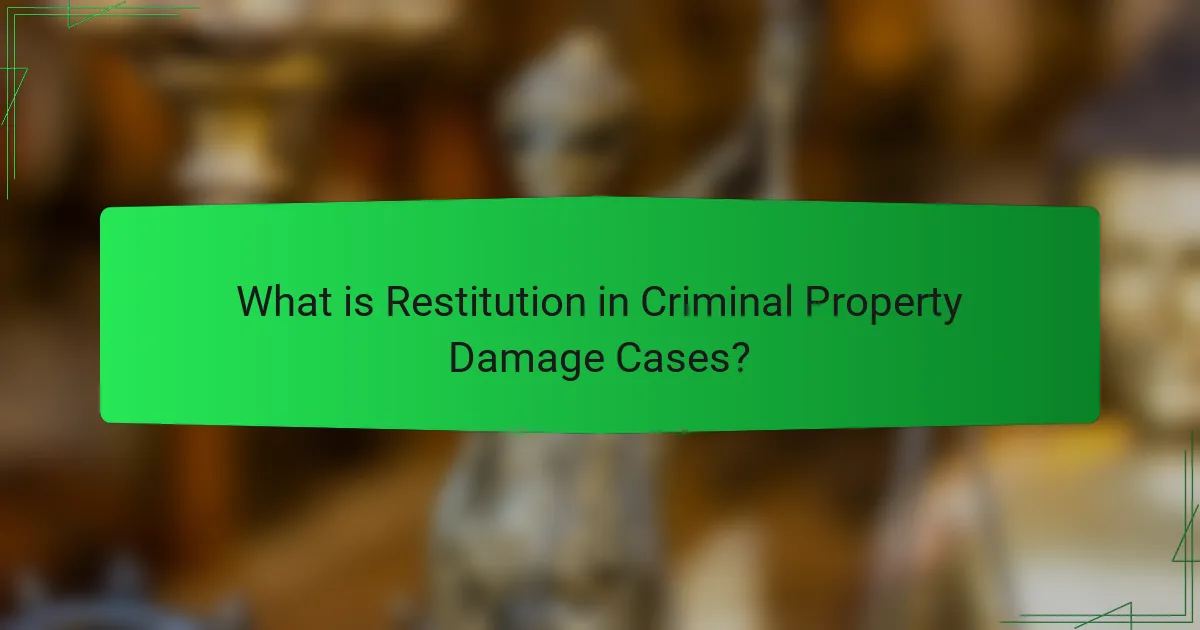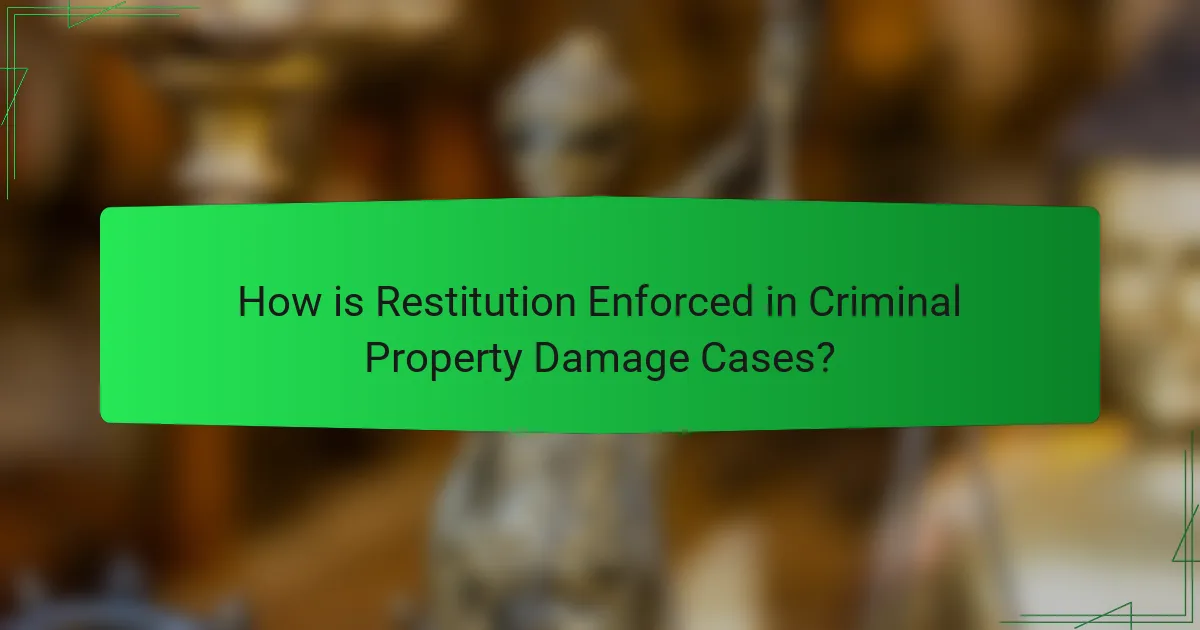Restitution in criminal property damage cases refers to the court-ordered payment made by an offender to a victim to compensate for losses or damages incurred. This payment aims to restore the victim’s financial state to what it was prior to the crime. The article outlines various calculation methods for determining restitution amounts, including the actual cost method, replacement cost method, and fair market value method. Additionally, it discusses the enforcement of restitution orders, highlighting legal mechanisms such as wage garnishment and liens to ensure compliance. The article emphasizes the importance of restitution in providing both punitive measures for offenders and financial relief for victims.

What is Restitution in Criminal Property Damage Cases?
Restitution in criminal property damage cases is a court-ordered payment made by the offender to the victim. This payment compensates the victim for the loss or damage incurred. Restitution aims to restore the victim to their pre-crime financial state. Courts typically determine the amount based on the actual costs of repair or replacement. In many jurisdictions, restitution is mandatory for convicted offenders. It serves both punitive and rehabilitative purposes. Victims may receive restitution for various damages, including repair costs and lost income. The enforcement of restitution orders can involve various legal mechanisms to ensure compliance.
How is restitution defined within the context of criminal law?
Restitution in criminal law is defined as the court-ordered payment by a defendant to a victim. This payment compensates the victim for losses incurred due to the defendant’s criminal actions. Restitution aims to restore the victim to their pre-crime financial state. It is often part of the sentencing phase in criminal cases. Courts determine the amount based on the actual damages suffered by the victim. This can include property damage, medical expenses, and lost wages. The legal basis for restitution can be found in various statutes and case law. For example, the Victim and Witness Protection Act provides guidelines for restitution in federal cases.
What are the legal foundations of restitution claims?
Restitution claims are based on legal principles that require a wrongdoer to compensate for losses caused by their actions. These claims are rooted in the concept of unjust enrichment. Unjust enrichment occurs when one party benefits at the expense of another without a legal justification. Restitution aims to restore the injured party to their original position before the loss occurred.
In criminal cases, restitution is often mandated by statutes. Many jurisdictions have laws that explicitly require restitution for victims of crimes. Courts typically assess the amount of restitution based on the actual damages incurred. This may include repair costs, lost wages, and other economic losses.
Judicial precedents also support the enforcement of restitution claims. Courts have consistently upheld victims’ rights to receive compensation. This reinforces the legal foundation for restitution in various contexts, including property damage.
How does restitution differ from other forms of compensation?
Restitution differs from other forms of compensation in that it specifically aims to restore the victim to their original position prior to harm. Unlike general damages, which may cover pain and suffering, restitution focuses solely on the financial loss incurred. It is often ordered by a court in criminal cases as part of the sentencing process. This ensures that the offender pays directly for the losses caused by their actions. Restitution is typically calculated based on the actual costs of damages, such as repair or replacement expenses. Other forms of compensation, like punitive damages, serve to punish the offender rather than to compensate the victim directly. Legal frameworks in many jurisdictions mandate restitution in cases of property damage, reinforcing its role as a corrective measure.
Why is restitution important in property damage cases?
Restitution is important in property damage cases because it holds the offender accountable for their actions. It aims to compensate the victim for losses incurred due to the damage. This financial remedy helps restore the victim’s property to its pre-damage condition. Studies show that restitution can reduce recidivism rates among offenders. A 2014 study by the Bureau of Justice Statistics found that offenders who paid restitution were less likely to reoffend. Additionally, restitution promotes a sense of justice for victims. It acknowledges their suffering and helps them recover from financial hardships. Overall, restitution serves both punitive and restorative functions in the justice system.
What impact does restitution have on victims of property crime?
Restitution positively impacts victims of property crime by providing financial compensation for their losses. It aims to restore victims to their pre-crime financial state. Victims receive payments that cover the cost of damaged or stolen property. This can alleviate some emotional distress associated with the crime. Research indicates that restitution can help improve victims’ sense of justice. Studies show that when victims receive restitution, they report higher satisfaction with the criminal justice process. Additionally, restitution can deter future crimes by holding offenders accountable. Overall, restitution serves as a crucial tool for supporting victims of property crime.
How does restitution contribute to the criminal justice system?
Restitution contributes to the criminal justice system by providing financial compensation to victims of crime. This process holds offenders accountable for their actions. It also aids in the restoration of victims’ losses, promoting their recovery. Additionally, restitution can deter future criminal behavior by emphasizing the consequences of crime. According to the Bureau of Justice Statistics, restitution orders can enhance victims’ satisfaction with the justice process. Furthermore, it reinforces the principle of repairing harm caused by criminal acts. Overall, restitution serves as a critical mechanism for balancing justice for both victims and offenders.

What are the Calculation Methods for Restitution?
Restitution calculation methods include the actual cost method, replacement cost method, and fair market value method. The actual cost method determines restitution based on the actual expenses incurred by the victim for repairs or replacements. This method reflects the precise financial losses suffered due to the crime. The replacement cost method estimates the amount needed to replace damaged property with similar items. This method accounts for current market prices for equivalent goods. The fair market value method assesses the value of the property before the damage occurred. This method considers what a willing buyer would pay to a willing seller in an open market. Each method provides a framework to ensure victims receive appropriate compensation for their losses. Courts often choose the method based on the specifics of the case and the evidence presented.
How is the amount of restitution determined?
The amount of restitution is determined based on the actual loss suffered by the victim. Courts assess the financial impact of the crime on the victim. This includes costs for repairs, replacement of property, and any related expenses. The restitution amount may also cover lost wages if applicable. Judges may consider evidence presented during the trial to establish these amounts. Documentation like invoices and estimates often supports the restitution claims. The goal is to make the victim whole again financially. State laws may influence the restitution process and its calculation.
What factors are considered in calculating restitution amounts?
Restitution amounts are calculated based on several key factors. These factors include the actual financial loss incurred by the victim. This loss can encompass property damage, lost wages, and medical expenses. Additionally, the court considers the defendant’s ability to pay. The severity of the crime and the intent of the offender also play a role in determining restitution. Courts may assess whether the offender has made any efforts to compensate the victim prior to sentencing. Legal statutes and guidelines in the jurisdiction can influence the calculation process as well. Overall, restitution aims to make the victim whole again, reflecting their losses accurately.
How do different jurisdictions approach restitution calculations?
Different jurisdictions approach restitution calculations through various legal frameworks and methodologies. In some areas, restitution is based on the actual financial loss incurred by the victim. This often includes repair costs, replacement value, and lost wages. Other jurisdictions may use statutory formulas to determine restitution amounts, which can standardize calculations across cases.
For example, some states have specific guidelines or caps on restitution amounts. These guidelines aim to ensure fairness and consistency in restitution awards. Additionally, jurisdictions may consider the defendant’s ability to pay when calculating restitution. This assessment can lead to adjusted amounts based on the financial situation of the offender.
Furthermore, some jurisdictions allow victims to present evidence of their losses during sentencing. This evidence can influence the final restitution order. Legal precedents also play a role in shaping how restitution is calculated. Courts often rely on previous rulings to guide their decisions in similar cases.
Overall, the approach to restitution calculations varies significantly, reflecting the legal standards and practices of each jurisdiction.
What types of damages are eligible for restitution?
Restitution can cover various types of damages. Eligible damages typically include property damage, lost wages, and medical expenses. Property damage refers to the cost of repairing or replacing damaged items. Lost wages account for income lost due to the crime. Medical expenses include costs for treatment related to injuries sustained. Courts often determine the amount based on evidence presented. Documentation of expenses is crucial for restitution claims. This ensures that victims receive fair compensation for their losses.
What are the categories of property damage covered under restitution?
Restitution covers several categories of property damage. These include direct damages, which are the costs to repair or replace damaged property. Indirect damages may also be included, covering losses that result from the damage, such as loss of use. Additionally, consequential damages can be considered, which are losses that occur as a foreseeable result of the property damage. Emotional distress damages may be applicable in some cases, reflecting the psychological impact of the damage. Each category aims to restore the victim to their original condition before the damage occurred.
How are intangible losses, such as emotional distress, factored into restitution?
Intangible losses, such as emotional distress, are factored into restitution through compensatory damages. Courts assess the impact of the emotional distress on the victim’s life. This assessment may include testimony from the victim and expert witnesses. The severity and duration of the emotional distress are also considered. Documentation of psychological treatment or therapy can support the claim. Jurisdictions vary on how they quantify these damages. Some states have caps on non-economic damages, affecting the restitution amount. Overall, restitution aims to make the victim whole by addressing both tangible and intangible losses.

How is Restitution Enforced in Criminal Property Damage Cases?
Restitution in criminal property damage cases is enforced through court orders that mandate the offender to compensate the victim. Courts typically determine the amount based on the cost of repairing or replacing the damaged property. Once ordered, the restitution becomes a legal obligation. Failure to comply can lead to additional penalties, including fines or imprisonment. Enforcement may involve wage garnishment or liens on property. Victims can also seek assistance from law enforcement to recover the owed restitution. Statutes in various jurisdictions outline the procedures for enforcement. These laws provide mechanisms to ensure victims receive the compensation they are entitled to.
What mechanisms exist for enforcing restitution orders?
Restitution orders can be enforced through various legal mechanisms. These mechanisms include wage garnishment, where a portion of the offender’s earnings is withheld to pay restitution. Courts may also place liens on the offender’s property to secure payment. Additionally, offenders may face probation conditions that require them to make restitution payments. Failure to comply can result in further legal consequences, including incarceration. Each jurisdiction may have specific laws governing these enforcement methods. Effective enforcement ensures that victims receive compensation for their losses.
How do courts ensure compliance with restitution payments?
Courts ensure compliance with restitution payments through various enforcement mechanisms. They may utilize wage garnishment to deduct payments directly from an offender’s paycheck. Courts can also impose liens on property, which prevents the sale of assets until restitution is paid. Additionally, probation or parole conditions often include restitution requirements. Failure to comply can lead to further legal consequences, such as incarceration. Courts monitor payment schedules and can modify them based on the offender’s financial situation. Some jurisdictions employ collection agencies to recover unpaid restitution. These methods collectively aim to enforce compliance and ensure victims receive compensation.
What role do collection agencies play in restitution enforcement?
Collection agencies play a crucial role in restitution enforcement by recovering owed amounts from offenders. They act on behalf of victims to collect restitution payments mandated by court orders. Collection agencies utilize various methods to locate debtors and negotiate payment plans. They may report unpaid debts to credit bureaus, which can impact the debtor’s credit score. This pressure often encourages debtors to fulfill their restitution obligations. According to the Federal Trade Commission, collection agencies are regulated to ensure fair practices while pursuing debts. Their involvement increases the likelihood that victims receive the financial compensation they are entitled to.
What challenges are associated with enforcing restitution?
Enforcing restitution faces several challenges. One major challenge is the difficulty in locating the offender’s assets. Many offenders may lack sufficient financial resources to pay restitution. Additionally, courts may struggle to assess the true value of damages accurately. Delays in the legal process can further hinder timely restitution payments. Victims may also encounter obstacles in navigating the legal system to claim their restitution. The lack of standardized procedures for enforcement can lead to inconsistencies across jurisdictions. Finally, some offenders may intentionally evade payment, complicating enforcement efforts.
What obstacles do victims face in receiving restitution?
Victims face several obstacles in receiving restitution. Legal complexities often hinder the process. Many victims lack knowledge about their rights and the restitution process. Financial constraints may prevent victims from pursuing claims. Additionally, the offender’s ability to pay can be a significant barrier. Victims may also experience emotional distress, which complicates their pursuit of restitution. Delays in the legal system can further frustrate victims seeking timely compensation. Finally, victims may encounter insufficient enforcement mechanisms to ensure restitution is paid.
How can legal reforms improve restitution enforcement processes?
Legal reforms can enhance restitution enforcement processes by streamlining procedures and clarifying legal standards. These reforms can establish clearer guidelines for calculating restitution amounts. They can also simplify the legal processes involved in enforcing restitution orders. Improved training for law enforcement and judicial personnel can ensure better understanding and implementation of restitution laws. Additionally, reforms can create stronger penalties for non-compliance with restitution orders. According to a study by the National Center for State Courts, jurisdictions with clear restitution laws see higher compliance rates. This evidence supports the notion that legal reforms can lead to more effective enforcement of restitution.
What best practices can increase the effectiveness of restitution in property damage cases?
Best practices to increase the effectiveness of restitution in property damage cases include clear documentation of damages. Accurate records of property condition before and after the incident help establish the extent of damage. Timely filing of restitution claims is crucial. Delays can complicate the recovery process and reduce the chances of successful restitution.
Engaging legal counsel can enhance the chances of successful restitution. Attorneys can navigate the legal complexities involved in restitution claims. Utilizing expert testimony can strengthen the case. Experts can provide credible assessments of damages and costs.
Regular follow-ups with the court can ensure that restitution orders are enforced. Courts may have mechanisms to track compliance and facilitate payment. Utilizing mediation can also be beneficial. Mediation allows for negotiation between parties, potentially leading to mutually agreeable restitution terms.
Finally, raising public awareness about restitution can encourage compliance. Educating the community about the importance of restitution may foster a culture of accountability.
Restitution in criminal property damage cases refers to the court-ordered payment made by an offender to a victim to compensate for losses incurred due to criminal actions. This article explores the calculation methods for restitution, including the actual cost, replacement cost, and fair market value methods, as well as the legal foundations and enforcement mechanisms in place to ensure compliance. Key factors influencing restitution amounts, types of damages eligible for restitution, and the challenges victims face in receiving compensation are also discussed. Overall, the article highlights the importance of restitution in promoting accountability and supporting victims within the criminal justice system.